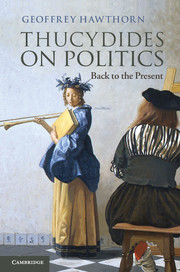Book contents
- Frontmatter
- Dedication
- Contents
- Preface and acknowledgements
- Chronology 545–323 BC
- List of maps
- Maps
- 1 The text
- 2 Writing power: Athens in Greece 478–435
- 3 Explaining the war: stated reasons 435–432
- 4 Explaining the war: true reasons 432
- 5 Judgements 431–430
- 6 Absent strategies 430–428
- 7 Speech and other events 428–427
- 8 Meaning and opportunity 426–424
- 9 Necessities 424
- 10 Interests 423–421
- 11 Emotion in deed 420–416
- 12 Purposes and decisions 415
- 13 Character and circumstance 414–413
- 14 One war 413–411
- 15 Back to the present
- Synopsis of the text by book and year
- Further reading
- References
- Index
11 - Emotion in deed 420–416
Published online by Cambridge University Press: 05 June 2014
- Frontmatter
- Dedication
- Contents
- Preface and acknowledgements
- Chronology 545–323 BC
- List of maps
- Maps
- 1 The text
- 2 Writing power: Athens in Greece 478–435
- 3 Explaining the war: stated reasons 435–432
- 4 Explaining the war: true reasons 432
- 5 Judgements 431–430
- 6 Absent strategies 430–428
- 7 Speech and other events 428–427
- 8 Meaning and opportunity 426–424
- 9 Necessities 424
- 10 Interests 423–421
- 11 Emotion in deed 420–416
- 12 Purposes and decisions 415
- 13 Character and circumstance 414–413
- 14 One war 413–411
- 15 Back to the present
- Synopsis of the text by book and year
- Further reading
- References
- Index
Summary
Dionysius of Halicarnassus delighted in ‘the old-fashioned wilful beauty’ of Thucydides’ writing, its ‘solidity, pungency, condensation, austerity, gravity and terrible vehemence’, and he was right to say that it ‘above all’ affected the emotions. Yet although Thucydides was fashioning his prose when the advent of writing was hastening moves in Greek to abstraction, he nowhere indicates that he himself thought of the emotions, feelings, pathe or pathemata as a class. He uses neither word for the generality and has no very elaborate lexicon in which to convey the particulars; he says less than one might expect about desire, pleasure, envy, pity, sadness, inner disturbance or shock; he writes often only of fear and hope and of orge, mood or disposition, the more definite connotation of which, when there is one, is anger rather than feelings of a calmer or more positive kind; and he barely mentions any other. On motive itself, he tends simply to mark its existence in the verb hormo, to be eager for something or be motivated to bring it about. His skill lies in conveying the emotion in the deed.
- Type
- Chapter
- Information
- Thucydides on PoliticsBack to the Present, pp. 148 - 164Publisher: Cambridge University PressPrint publication year: 2014



